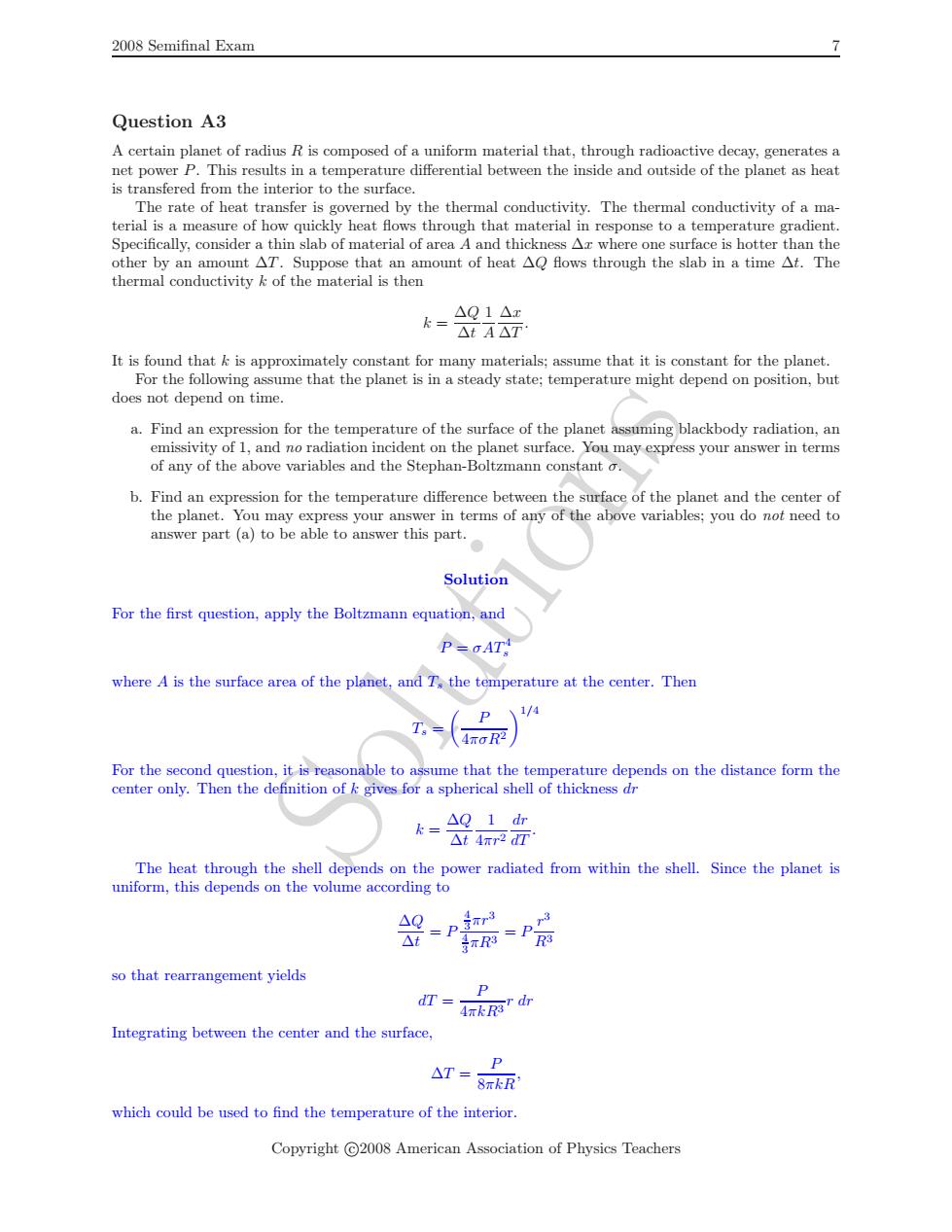正在加载图片...

2008 Semifinal Exam 7 Question A3 A certain planet of radius R is composed of a uniform material that,through radioactive decay,generates a net power P.This results in a temperature differential between the inside and outside of the planet as heat is transfered from the interior to the surface. The rate of heat transfer is governed by the thermal conductivity.The thermal conductivity of a ma- terial is a measure of how quickly heat flows through that material in response to a temperature gradient. Specifically,consider a thin slab of material of area A and thickness Ax where one surface is hotter than the other by an amount AT.Suppose that an amount of heat AQ flows through the slab in a time At.The thermal conductivity k of the material is then 214 △tA△T It is found that k is approximately constant for many materials;assume that it is constant for the planet. For the following assume that the planet is in a steady state;temperature might depend on position,but does not depend on time. a.Find an expression for the temperature of the surface of the planet assuming blackbody radiation,an emissivity of 1,and no radiation incident on the planet surface.You may express your answer in terms of any of the above variables and the Stephan-Boltzmann constant o. b.Find an expression for the temperature difference between the surface of the planet and the center of the planet.You may express your answer in terms of any of the above variables;you do not need to answer part (a)to be able to answer this part. Solution For the first question,apply the Boltzmann equation,and P=0AT where A is the surface area of the planet,and T the temperature at the center.Then 1/4 T81 \4ToR产 For the second question,it is reasonable to assume that the temperature depends on the distance form the center only.Then the definition of k gives for a spherical shell of thickness dr △Q1dr △t4πr2dT The heat through the shell depends on the power radiated from within the shell.Since the planet is uniform,this depends on the volume according to △Q 3 R3=P R3 so that rearrangement yields P dT=. AxkRr dr Integrating between the center and the surface, △T= P 8元kR which could be used to find the temperature of the interior. Copyright C2008 American Association of Physics TeachersSolutions 2008 Semifinal Exam 7 Question A3 A certain planet of radius R is composed of a uniform material that, through radioactive decay, generates a net power P. This results in a temperature differential between the inside and outside of the planet as heat is transfered from the interior to the surface. The rate of heat transfer is governed by the thermal conductivity. The thermal conductivity of a material is a measure of how quickly heat flows through that material in response to a temperature gradient. Specifically, consider a thin slab of material of area A and thickness ∆ x where one surface is hotter than the other by an amount ∆ T . Suppose that an amount of heat ∆ Q flows through the slab in a time ∆ t. The thermal conductivity k of the material is then k = ∆ Q∆t 1A ∆ x ∆ T . It is found that k is approximately constant for many materials; assume that it is constant for the planet. For the following assume that the planet is in a steady state; temperature might depend on position, but does not depend on time. a. Find an expression for the temperature of the surface of the planet assuming blackbody radiation, an emissivity of 1, and no radiation incident on the planet surface. You may express your answer in terms of any of the above variables and the Stephan-Boltzmann constant σ . b. Find an expression for the temperature difference between the surface of the planet and the center of the planet. You may express your answer in terms of any of the above variables; you do not need to answer part (a) to be able to answer this part. Solution For the first question, apply the Boltzmann equation, and P = σAT 4s where A is the surface area of the planet, and Ts the temperature at the center. Then Ts = P 4πσR 2 1 / 4 For the second question, it is reasonable to assume that the temperature depends on the distance form the center only. Then the definition of k gives for a spherical shell of thickness dr k = ∆Q∆t 1 4πr2 dr dT . The heat through the shell depends on the power radiated from within the shell. Since the planet is uniform, this depends on the volume according to ∆Q∆t = P 43 πr 3 43 πR 3 = P r 3 R3 so that rearrangement yields dT = P 4πkR 3 r dr Integrating between the center and the surface,∆ T = P 8πkR , which could be used to find the temperature of the interior. Copyright c 2008 American Association of Physics Teachers